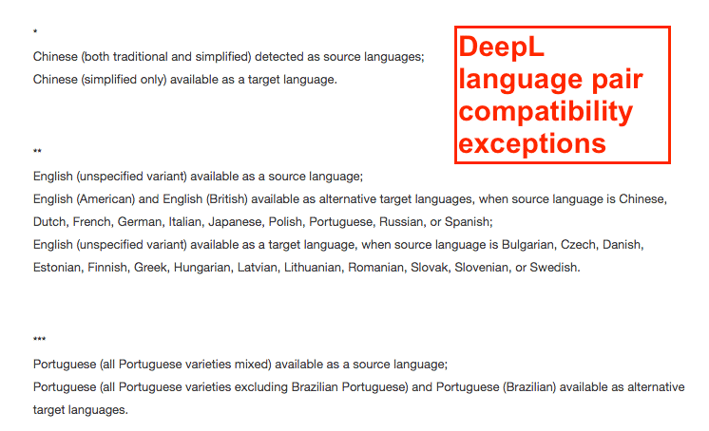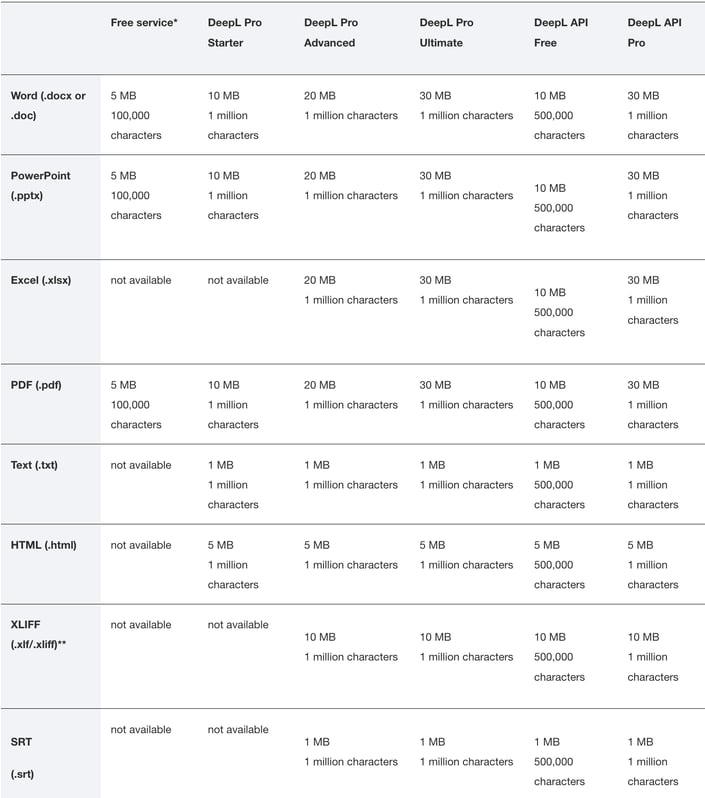Want the best DeepL alternative for your team? You’re in luck—plenty of alternatives to DeepL Pro are available. While DeepL is a popular CAT tool (particularly among Europeans), there are several reasons you might be searching for DeepL alternatives for enterprise use.
However, you must consider the fact that all premium CAT software is a significant investment.
You should get clear on why exactly you’re looking for a better alternative to DeepL. That way, you don’t adopt another platform that presents the same challenges you encountered with your original software.
We’re here to help you do just that!
In this post, you’ll explore various DeepL drawbacks and user-specific needs you might identify with. As a result, you can conclude whether alternatives to DeepL could fill these gaps. This will equip you to find the best tool for your needs.
You’ll also see a recommendation for the best DeepL alternative at the bottom of this post.
14 reasons to adopt a DeepL alternative
1. Larger file size allowance with a DeepL alternative
One of the top reasons you might seek a DeepL alternative is the 50MB file size limit. If you want to upload a file for translation in DeepL, it must be no larger than 50MB. For enterprises that need to translate large files (especially files with graphics or images), this will hinder productivity.
2. Language pair compatibility
With DeepL alternatives, you have more flexibility and access to language pairs. While DeepL is known for high translation satisfaction in select European language pairs, there are limited language pairs available for general translation.
Additionally, these same language pairs aren’t necessarily available for glossaries.
Underneath their language pairs list, DeepL presents exceptions. These are difficult to remember and can make it confusing for enterprises who wish to scale their multilingual communication projects using DeepL alone.
To illustrate this, we’ll provide a preview of the DeepL language pair compatibility exceptions below.

Language pairs with glossary support
Additionally, these same language pairs aren’t necessarily available for glossaries.
DeepL continues to improve language support, but limitations persist—especially when it comes to glossaries. For example, glossary support is not yet available for Arabic, Japanese, or Chinese. This poses a challenge for enterprises that need consistent terminology across all target markets.
3. Number of translated files
On DeepL Pro’s plans page, you’ll notice they present limits on numbers of files you can translate within each subscription tier. For example, the Advanced plan allows up to 20 document translations per user per month, while the Ultimate plan permits up to 100.
If your company needs to translate more files each month than what they accommodate, your best DeepL alternative will be a solution that charges by # of words versus files.
4. Non-European language needs
If your company plans to expand outside of European markets or reach audiences outside of Europe, you’re right to seek a DeepL alternative. For example, a significant amount of Asian languages aren’t supported. This has to do with the translation engine they use.
DeepL has made strides in expanding its language selection, recently adding Arabic, Korean, Norwegian Bokmål, Traditional Chinese, and Ukrainian. But if your business needs support for less common languages, such as Thai, Swahili, or certain Indian and African languages, you may find DeepL’s offerings don’t cover all your needs.Look for translation software that uses Microsoft’s or Google’s translation engine, for more options.
5. Identity and Access Management (IAM)
This argument for adopting a DeepL alternative is focused on security.
If your organization is serious about security, your IT team is likely requiring software solutions to include IAM integrations. They provide a great balance between accessibility and security. Some examples of IAM tools include Single Sign-On, OKTA and Microsoft Azure AD.
While DeepL now supports Single Sign-On (SSO) for enhanced user authentication and offers early integration with Azure AD, there is no official mention of direct support for MFA or other tools aside from SSO.
However, if your organization needs full IAM compatibility—including multi-factor authentication, user provisioning, and advanced role permissions—you’ll need a more robust solution.
6. Web-based translation of multiple documents
According to DeepL’s website, “Multiple documents can only be translated with the DeepL for Windows and DeepL for Mac apps.” However, they have added an option to switch back to an older version within the Windows app to support batch file translations.
Batch translation in DeepL remains mostly tied to desktop apps and comes with a learning curve. If you prefer web-based simplicity—especially across team members—alternatives could offer cleaner, centralized control.
So if you prefer to translate batches of files online and this limitation is inhibiting your productivity, find a web translator alternative to DeepL Pro.
7. DeepL’s file type compatibility is expanding – but still limited
Recently, DeepL added support for Microsoft Excel (.xlsx) and subtitle files (.srt), which is a step in the right direction. The platform now fully supports .docx, .pptx, .pdf, .html, .txt, and .xliff (version 2.1).
However, if you wish to translate Google Drive files or need an InDesign file translator, you will be out of luck with DeepL.
The full list of files that DeepL can currently translate are listed below, in this screenshot taken from their website.

As you can see, they include several important file types. However, the list is rather small. When you invest in a DeepL alternative, make sure you have a list in hand of all the file types your company will possibly need to translate.
DeepL alternatives offer broader file format support
An enterprise alternative to DeepL–such as Pairaphrase –supports not only the formats supported by DeepL but also additional ones such as the ones highlighted below in bold (overall, a total of 24 file formats):
- Microsoft
- Word (.docx)
- Excel (.xlsx)
- PowerPoint (.pptx)
- Outlook (.msg)
- Google Drive (also read about our Google Drive integration below)
- Google Docs (.gdoc)
- Google Sheets (.gsheet)
- Google Slides (.gslides)
- Adobe
- Digital PDF (.pdf)
- Scanned PDF (.pdf)
- InDesign (.idml)
- E-learning
- XLIFF 1.2 (only for DeepL Pro advanced and above)
- XLIFF 2.0
- YouTube Subtitles (.srt)
- MicroDVD subtitle files (.sub)
- Software Development
- Resource Files (.strings)
- JSON (.json)
- Portable Objects (.po)
- XML
- XML for Android
- Other
- Email (.eml)
- HTML
- AutoCAD (.dxf)
- Rich Text Format (.rtf)
- Plain Text (.txt)
This extensive compatibility ensures that teams across various departments can seamlessly translate documents without the need for manual conversions or adjustments.
8. Can’t translate into multiple languages simultaneously
If your team wants to translate a document into multiple languages at once, they're out of luck when it comes to DeepL. As a DeepL Pro user, you can only translate one document into one target language at a time.
9. Alternatives to DeepL might be more secure
DeepL promises “Maximum Data Security” which includes end-to-end encryption and data scrubbing. They have also recently achieved ISO 27001 and SOC 2 Type 2 certifications, enhancing their enterprise-grade security offerings.
However, there are additional security measures you must look for as an enterprise user.
If your organization requires enterprise-level security including multi factor authentication, compliance audits (such as HIPAA, GDPR, or SOC 2 compliance requirements), a Well-Architected Review or ongoing vulnerability scans, we advise you to find a more secure alternative to DeepL.
Handling sensitive data?
Companies handling sensitive customer data or proprietary business information may need to look deeper into security and compliance certifications before fully committing. There are high societal risks of uninformed machine translation use, particularly in healthcare and legal contexts, where inaccuracies can lead to severe consequences.
10. Collaboration tools
If your company collaborates on translations, it appears this currently isn’t fully possible with DeepL. However, if it is a priority, you can use APIs to integrate with third party tools that can make collaboration possible.
For basic collaboration, teams can copy translated text into shared documents for feedback, or use DeepL Pro to share glossaries. DeepL Voice also allows real-time spoken translations, which can be helpful in multilingual meetings.
Limitations to translation collaboration in DeepL
Unfortunately, it is still limited compared to full-fledged Translation Management Systems. Alternative options can provide the tools required for collaborative translation efforts such as real-time collaborative editing.
Look for features such as translation tracking, in-project instant messaging, segment edit history and bookmarking, as well as the sharing of translation memories and glossaries.
11. eLearning translations
Does your company use eLearning for internal training? If so, a DeepL alternative could provide you with the ability to translate eLearning files. While DeepL supports .txt file translation, XLIFF translation and .srt subtitle file translations, it lacks native support for specialized eLearning file formats.
Look for a translation solution with .sub subtitle file compatibility, as well as a foreign language voice-over generator.
12. Professional editing tools + spellcheck
DeepL has limited UI for editing. For example, they lack inline segment tools or spellcheck.
Professional editing, often built right into some translation software, combines Machine Translation with human review tools. You can fine-tune translations in-app, with auto spell check and edit tracking included. No need to copy-paste into Word just to catch a typo.
13. Your team lives in Google Drive
Does your team work extensively in Google Drive? Unfortunately, DeepL doesn’t have a native Google Drive translation integration.
Your translation software should offer seamless Google Drive integration to translate your Google Docs, Sheets, and Slides straight from Google Drive. It’ll help you avoid downloads and format breaks.
For distributed teams that collaborate in real-time across cloud files, this kind of integration is more than a convenience—it’s a time-saver that helps avoid versioning errors.
If your files start in Google Drive and end in Google Drive, it might make sense to use a translation platform that fits that workflow natively.
14. You need an (AI) translation assistant on your team
Not every translation is cut-and-dry. Maybe you're unsure how formal the tone should be. Or you're wrestling with how to phrase something that doesn’t quite map across languages. You could switch over to ChatGPT and try your luck—or you could stay focused with a tool that brings GPT right into the workflow.
DeepL alternatives provide ChatGPT integration
Pairaphrase includes built-in ChatGPT support trained specifically for translation. It’s like having an assistant on hand to help rewrite sentences, suggest terminology, or offer tone tweaks—on demand, in context, and without slowing you down.
While DeepL offers a separate tool called DeepL Write for editing English and German text, it’s not integrated into the translation process, doesn’t support AI translation prompts, and doesn’t assist across languages. For real in-line AI assistance, look for platforms that embed GPT where your team is already working.
Use the best MT engine for the job
DeepL is great—but it’s not always the right fit for every type of content. Legal documents, technical manuals, marketing copy, and medical content all have different translation requirements. That’s why sticking to just one engine can limit your results.
Other translation software should let you choose from multiple top-tier Machine Translation engines—including DeepL, Microsoft, Google, AWS, and OpenAI—so you can match the right engine to your content.
Watch the video below to see some key differences between the Google Translate, ChatGPT, and Microsoft Translator engines.
Reasons to stick with DeepL
Even with its limitations, DeepL remains one of the top machine translation engines, especially for Western European languages.
Despite what you read in this article, you should do additional research on forums (such as ProZ and Quora) as well as independent review websites, to see if a switch is truly right for your company. In some cases, you very well might want to stick with using DeepL for your translation needs.
After all…
- DeepL has the core functionality offered by many CAT tools
- It can be integrated with some 3rd party apps such as Trados Studio and memoQ
- DeepL has a great command of select European language pairs
That said, if your business needs greater security, support for more languages, larger file limits, or enhanced collaboration features, you may need to look for an alternative.
Alternatively, you could adopt translation software with DeepL engine integration.
DeepL integration within Pairaphrase
Pairaphrase recently announced the integration of DeepL as part of its suite of translation engines. This means Pairaphrase users can now leverage DeepL’s engine alongside Google Translate, Microsoft Translator, OpenAI’s GPT-based translation, and AWS Translate within a single platform.
Best DeepL alternative
Want to get started with the best alternative to DeepL? Try Pairaphrase. It’s the AI-powered Translation Management System for teams that value smarter, faster and safer translation.

Pairaphrase supports 140+ languages and 20,000+ language pairs. Translate into Spanish, English, French, German, Arabic, Hindi, Chinese, Japanese and more. Not to mention, Pairaphrase performs file translation for 24 file types.
Just one translation with Pairaphrase can cover your annual subscription!
Get Started
Schedule a demo or share this article with a colleague.


.png)

.png)




